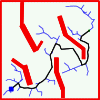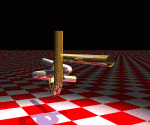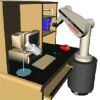
OverviewRRT-Connect is a simple and efficient algorithm for solving single-query path planning problems in high-dimensional configuration spaces. Inspired by classical AI bidirectional search, the method works by incrementally building two Rapidly-exploring Random Trees (RRTs) rooted at the start and the goal configurations. The trees each explore space around them and also advance towards each other through the use of a greedy heuristic. (See algorithm animations) The algorithm was designed to be both general and practical, and has been successfully applied to a variety of challenging planning problems. Some of the key advantages of RRT-Connect include:
Path PlanningPath planning problems arise in such diverse fields as robotics, assembly analysis, virtual prototyping, pharmaceutical drug design, manufacturing, and computer animation. Path planning problems generally involve computing a continuous sequence ("a path") of configurations (generalized coordinates) between an initial configuration (start) and a final configuration (goal) while respecting certain constraints.The "basic path planning problem" involves computing a collision-free path between two configurations in a static environment of known obstacles. In this case, the constraints on the solution path arise from the geometry of both the obstacles and the "robot" (the object for which a path is being computed). If the robot can be represented as a single 3D rigid object that rotates and translates in a 3D environment, then the problem is sometimes referred to as "the piano-mover's problem". "Path Planning" vs. "Motion Planning"The term "motion planning" is usually distinguished from "path planning" in that the computed path is parameterized by time (i.e. a trajectory). The consideration of "time" or "system dynamics" (physics) is often important for problems requiring time-parameterized solution trajectories.Rapidly-exploring Random Trees (RRTs) were initially designed to plan open-loop trajectories for systems with nonholonomic constraints induced by system dynamics("kinodynamic planning"). Subsequently, RRT-Connect was developed to efficiently solve instances of the "basic path planning problem" involving holonomic systems. It was first used for automatically generating collision-free object manipulation motions for animated characters in interactive 3D virtual environments. Since then, the algorithm has been refined and applied to a broad class of interesting and challenging planning problems. |
References and Further Information
- NEW - Available soon: Improved RRT-Connect algorithm: Revised journal version.
[Computed Examples]
[Software]
- Motion Planning for Humanoid Robots using various adaptations of RRT-Connect.
- RRT-Connect algorithm with preliminary analysis: J.J. Kuffner and S.M. LaValle.
RRT-Connect: An efficient approach to
single-query path planning.
In Proc. IEEE Int'l Conf. on Robotics and Automation
(ICRA'2000), San Francisco, CA, April 2000.
[Abstract]
[PDF]
[Computed Examples]
- Movie clip of Computed Examples:
J.J. Kuffner and S.M. LaValle. RRT-Connect: An efficient approach
to single-query path planning. Video Proc. of IEEE Int'l Conf. on Robotics and Automation (ICRA'2000), April
2000.
[MoreInfo]
- Kinodynamic Planning with RRTs: S.M. LaValle and J.J. Kuffner.
Randomized kinodynamic planning.
International Journal of Robotics Research, 20(5):378-400, May
2001.
[Abstract]
[PDF]
[MoreInfo]
- Overview of RRTs for path and trajectory planning: S.M. LaValle and J.J Kuffner.
Rapidly-exploring random trees: Progress and prospects.
In Robotics: The Algorithmic Perspective. 4th Int'l Workshop on the
Algorithmic Foundations of Robotics., Hanover, NH, 2000. A. K.
Peters.
[Abstract]
[PDF]
[MoreInfo]
- Original Holonomic RRT-Connect algorithm (Chapter 5): J.J. Kuffner Jr. Autonomous Agents for Real-time
Animation. PhD thesis, Stanford University, Stanford, CA,
December 1999. [Abstract] [PDF] [MoreInfo]
- Original Kinodynamic RRT Paper: S.M. LaValle and J.J Kuffner.
Randomized kinodynamic planning.
In Proc. IEEE Int'l Conf. on Robotics and Automation (ICRA'99),
Detroit, MI, May 1999.
[Abstract]
[PDF]
[MoreInfo]
- The RRT Page at UIUC (contains many links to papers, presentations, and free software).



